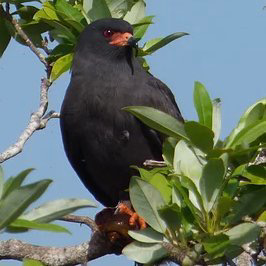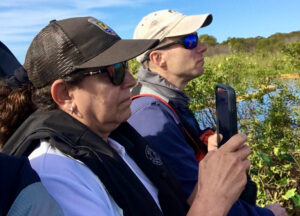By J. Scott Angle
We know whether the Everglade snail kite becomes more or less endangered every few hours. At least we do at Lake Tohopekaliga, an 18,810-acre lake located southeast of Kissimmee
A University of Florida research team is always counting. They use GPS trackers, nest cameras and airboats, not to mention old-fashioned binoculars, to verify the data that comes in through the gadgetry.

The constant updates inform decisions on whether to let water in or out of Lake Toho. It also guides decisions to restrict access around nests or rip out weeds to make way for bass and tour boats without starving the bird.
Even if you don’t care about birds, this work might protect something you do care about — bass, if you’re a fisher; ducks, if you’re a hunter; airboat tours, if you’re a visitor, business owner or employee; and tax dollars if you’re a Floridian who benefits from the economic activity a healthy home for the snail kite generates.
UF Institute of Food and Agricultural Sciences ecologist Rob Fletcher leads the statewide snail kite monitoring program. Fletcher is largely responsible for providing scientific information to answer questions of when to turn the lake’s plumbing on and off and other human controls on a wild space surrounded by busy boulevards, condos and commerce.
The Florida Fish & Wildlife Conservation Commission (FWC), the U.S. Army Corps of Engineers, the U.S. Fish & Wildlife Service (USFWS) and the South Florida Water Management District depend on the data in deciding what to do at the lake and elsewhere throughout the kites’ range.
That range includes Everglades National Park, Lake Okeechobee, Lake Kissimmee and Lake Istokpoga in Highlands County. It’s even been spotted on Paynes Prairie outside Gainesville and in the Panhandle.
The kite takes its name from where it was first spotted more than a century ago.
Fletcher just wants what the agency officials want — the data and insights needed to make the best possible decisions. They all want you — and your grandchildren — to have the chance to see such a rare bird.

If you do see it, you can help Fletcher and his team by recording your sighting at eBird, where you can see where others have spotted it.
Fletcher wanted me to see it, too. So he and the FWC’s snail kite expert Tyler Beck took me out on Lake Toho. And they brought along their colleague Vicki Garcia of USFWS, which enforces the Endangered Species Act.
That it only took about 15 minutes from the moment I stepped out of my car until I had a kite in my sights testified to how well they’re doing their job.
The snail kite is one of conservation’s success stories. Though it remains on the federal endangered species list, management efforts like that of the government-university team has helped the bird come back from the brink of extinction. In 2008 the population was down to about 750. It’s nearly triple that today.
That’s why we need public support for environmental science. That can come in the form of funding, public participation in public policy forums, or citizen science initiatives like eBird.
It's always satisfying to watch a snail kite use their specialized hook bill to extract an apple snail from it's shell. This adult male looks especially adept! pic.twitter.com/g6ddWVjSRV
— UF Snail Kites (@ilove2eatsnails) September 8, 2021
New questions arise as conditions change. For example, when an invasive snail populated Toho, officials needed to decide whether to better control the weeds upon which those snails feed. Was it a case of invasive species vs. endangered species? Fletcher, Beck and others discovered that the snail kite actually did just fine feeding on the exotic snail, and lake managers have adjusted their weed control strategy accordingly.
Beck and other agency officials make Fletcher’s work relevant. What they are doing is making it possible for us to live right up to the edge of where a bird struggles against extinction.

One of the strengths of a great public research university is the way it combines teaching with research. Graduate students in Fletcher’s lab count birds, document nest locations and track movement.
The field experience, education and collaboration with government agency professionals are preparing them to become the next generation of another small and select species — the wildlife scientist.
J. Scott Angle is the University of Florida’s Senior Vice President for Agriculture and Natural Resources and leader of the UF Institute of Food and Agricultural Sciences (UF/IFAS). He can be reached ai jangle@ufl.edu or on Twitter @IFAS_VP
Display photo of snail kite was taken by Caroline Poli.




Comments 2